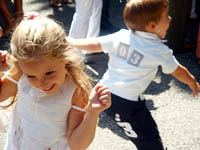This is a game of leapfrog. The players are divided into two parties. Half of them form one continuous “back,” on which the other half jump, one at a time, until all are seated. The players who form the “back” stand one behind another, the first player resting his head against the stomach of one who stands upright, backed by a wall or fence. Each player in turn grasps the coat tail or waist of, and rests his head or shoulder against, the player next in front. They should thus make one long, even, and solid “back” or row of backs. These are called the buckets. The other players are called the bungs, and stand at some little distance to get a run for the leap. They will naturally select their best leaper as the first of their line, as he may not move forward after he has once landed on the backs, and it is desirable that he should leave as much space behind him as possible for the others to sit. None of the players may move forward after once landing on the backs. If all of the bungs succeed in seating themselves without any break occurring among the buckets, it counts one in favor of the buckets. When such a breakdown occurs, the two parties change places, the bungs taking the place of the buckets; otherwise the game is repeated with the same bungs and buckets. The party wins which has the highest score to its credit at the end.
Games for the Playground, Home, School and Gymnasium by Jessie Hubbell Bancroft
